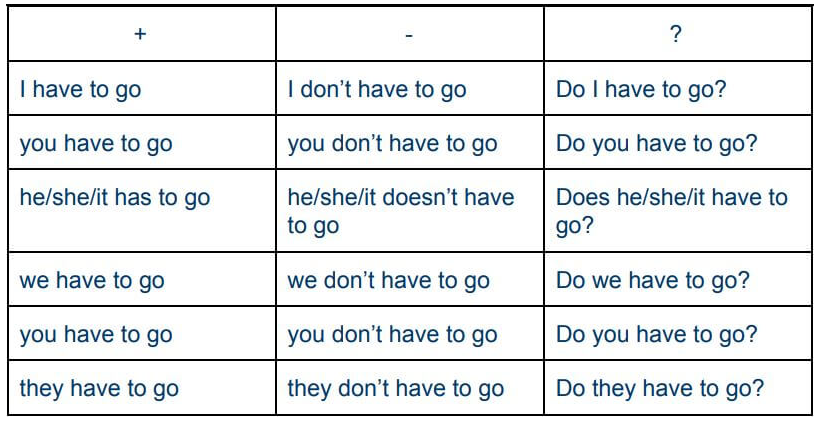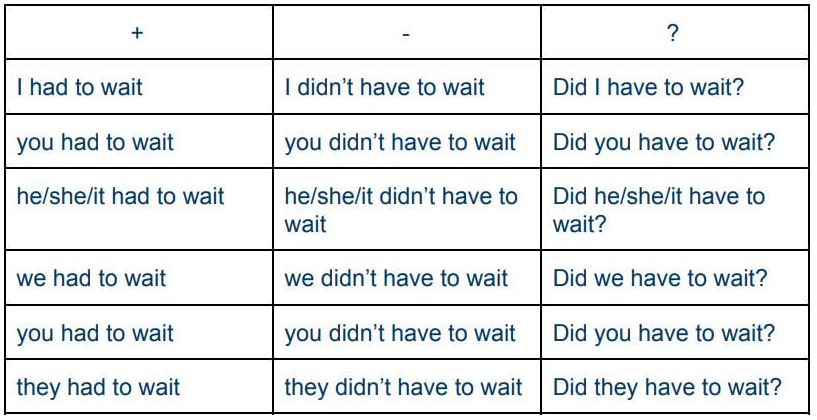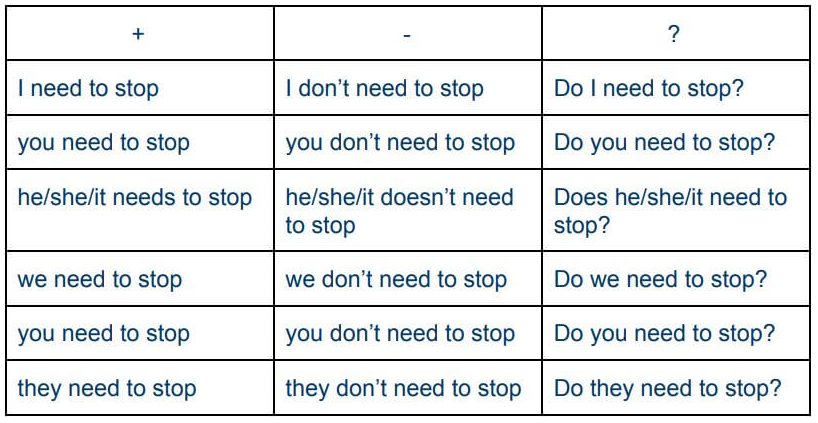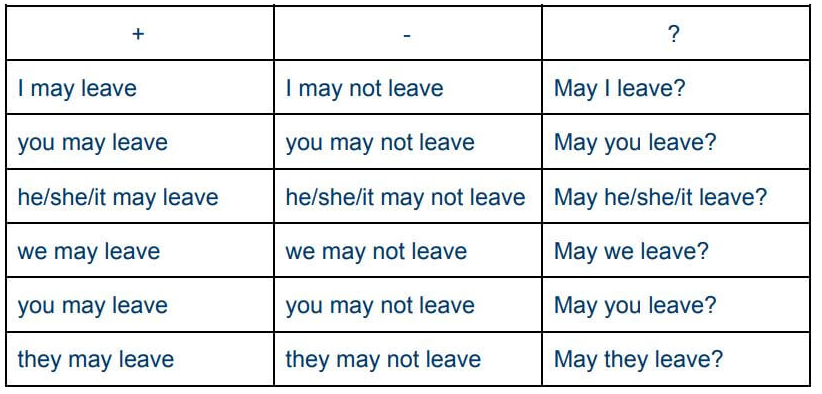Las diferencias entre ‘Must’, ‘Have to’, ‘Shall’, ‘Need’ y ‘May’
En inglés hay varias formas de describir las normas y las obligaciones, y como estudiante puede resultar complicado entender qué forma es la adecuada para cada situación. Aquí tienes una descripción de cada verbo modal que utilizamos para expresar obligación y cómo y cuándo utilizarlos.
Must
‘Must’ es la forma básica y más directa de decir que algo es obligatorio. Significa que no tienes más remedio que hacer (o no hacer) una acción. Sólo podemos utilizar "must" en presente para describir una obligación general o permanente, o una obligación en un futuro próximo. La estructura de "must" es fácil porque es la misma para todos los sujetos:

Aquí tienes algunos ejemplos:
When you drive you must wear a seatbelt.
They must hand in their projects before the 8th June.
I must remember to send a birthday card to my Dad.
He must study harder if he wants to pass the exam.
We must get to the airport two hours before the flight.
Para hacer oraciones negativas añadimos 'not que normalmente se contrae a n't:

Usamos 'mustn't' para expresar una prohibición o una fuerte obligación. Por ejemplo:
When the traffic lights are red you mustn’t go.
They mustn’t use their mobile phones during lessons.
We mustn’t stand up while the plane is taking off.
I mustn’t drink any more coffee, otherwise I won’t sleep tonight.
She mustn’t go outside without a jacket. It’s really cold.
Passengers must not lean on the doors.
Es posible hacer preguntas con 'must', pero no es muy común en el inglés moderno. Para hacer la forma interrogativa invertimos el sujeto y 'must':

Aquí tienes algunos ejemplos:
Must I go to the party? I don’t really want to.
What time must we leave? Not later than 2pm.
Must he make so much noise? It’s really annoying.
Why must the children do so much homework?
What must you wear at work?
Who must we call for an appointment?
Have to
En la forma afirmativa, "have to" tiene el mismo significado que "must" y se utiliza para expresar obligaciones. Sin embargo, 'have to' es mucho más flexible que 'must' porque podemos utilizarlo en pasado, presente y futuro. Por eso se utiliza mucho en el inglés moderno. Su estructura es la misma que la de cualquier verbo normal:

He aquí algunos ejemplos de frases afirmativas:
I have to email the supplier before he sends the goods.
We have to do the shopping because the cupboards are empty.
She has to take two trains and a bus to get to work every day.
You have to practice if you want to be fluent.
Motorcyclists have to wear a helmet.
If you’re a foreigner you have to fill in a landing card.
Usamos preguntas con 'have to' para preguntar si algo es obligatorio, y las preguntas con 'have to' son mucho más comunes en el inglés moderno que las preguntas con 'must'. Aquí tienes algunos ejemplos:
What time do you have to start work?
Do we have to take anything with us to the course?
Why do they have to do overtime? – Because their deadline is tomorrow.
Does he have to wear a suit to work?
Do I have to bring some form of ID?
What do we have to do now?
La forma negativa de "have to" tiene un significado muy distinto de "mustn't". Usamos "don't have to" para decir que algo no es necesario y que no hay obligación. Por ejemplo:
When you ride a bicycle you don’t have to wear a helmet, but it’s a good idea.
She doesn’t have to come to the meeting if she doesn’t want to.
We don’t have to wear uniforms to school in Italy.
I don’t have to work on Saturdays so I can do what I want.
They don’t have to read all the books the teacher recommended, just one of them.
You don’t have to pay to use the motorways in England. They are free.
Obligaciones en el pasado y en el futuro
Para describir una obligación en el pasado, la única forma posible es el pasado de 'have to', que es 'had to'. El pasado simple de "must" es "had to". La estructura es la misma para todos los sujetos:

Por ejemplo:
I had to wait a long time for my bus.
We didn’t have to use our passports. They accepted our ID cards.
Did you have to pay a fine when the police stopped you?
The doctor told her she had to lose weight.
They had to queue up for two hours to get through security. They almost missed their flight.
You had to do a lot of conference calls in your last job, didn’t you?
También podemos usar 'have to' en otros tiempos verbales, como el presente perfecto cuando queremos describir obligaciones recientes u obligaciones dentro de un periodo de tiempo inacabado. Por ejemplo:
I’ve had to work a lot this week.
She’s had to leave early because her daughter is sick.
They haven’t had to go to the doctor for years. They’ve very healthy kids.
También podemos usar 'have to' con 'will' para describir una obligación, o falta de obligación, en el futuro. Por ejemplo:
You’ll have to work hard if you want to get a promotion.
We’ll have to hurry up. The film starts in ten minutes.
She won’t have to start her job until next month, so she’s going on holiday.
Will they have to sign a register during lessons?
I’ll have to train hard for the marathon. I’m not fit enough yet.
You’ll have to tell Marie the truth, otherwise you’ll get into trouble.
¿Must o Have to?
¿Cuándo se utiliza "must" y cuándo "have to"? En general, en el presente afirmativo se puede utilizar tanto "must" como "have to". Sin embargo, hay una pequeña diferencia cuando hablamos en primera persona. Cuando quieres describir una obligación interna (una orden que te das a ti mismo), es mejor utilizar 'must'. Por ejemplo:
These pants don’t fit me anymore. I must lose weight.
Por el contrario, cuando describes una obligación externa (una orden que alguien te da) utilizamos 'have to'. Por ejemplo:
My doctor told me I’m overweight and I have to go on a diet.
En cambio, cuando las órdenes son generales y oficiales, por ejemplo en avisos y documentos, solemos utilizar "debe". Por ejemplo:
Passengers must keep their bags with them at all times.
En las frases negativas debes recordar que si quieres describir una obligación de no hacer algo, debes utilizar "mustn't". Si lo que quieres decir es que no hay obligación, utiliza "don't have to". Por ejemplo:
You mustn’t do that! (Don’t do it because it is not permitted.)
You don’t have to do that. (You have no obligation to do it but you can if you want to.)
Shall
En algunos documentos y situaciones oficiales se utiliza "shall" para describir obligaciones formales. Por ejemplo:
Employees shall provide a medical certificate for sick leave.
Both parties shall give reasonable notice if they cannot attend the hearing.
Hotel guests shall pay for any damage to the rooms.
Members shall not use the gym equipment without a demonstration from the staff.
You shall wear your ID badge at all times.
Applicants shall come to interviews with their CV and copies of their qualifications.
Need
Utilizamos "need" para describir una necesidad. Tiene un significado muy parecido al de obligación y, por tanto, puede ser una forma más educada de decir "must" o "have to". Inusualmente, "need" es tanto un verbo normal como un verbo modal. En casi todos los casos se puede utilizar la forma normal, que tiene una estructura regular:

Aquí tienes algunos ejemplos:
We need to fill up with petrol. The tank is almost empty.
Do you need anything from the shops?
They don’t need to come early. They can come whenever they’re ready.
En inglés moderno, 'need' como verbo modal sólo se utiliza realmente en la forma negativa y sin 'to'. Por ejemplo:
You needn’t do the washing up. I’ll do it later.
They needn’t complete the work right away. There’s plenty of time.
She needn’t worry about going to the dentist’s. He’s very kind.
May
Utilizamos "may" para pedir y dar permiso formalmente. La estructura de 'may' es como la de cualquier otro verbo modal:

Aquí tienes algunos ejemplos:
May I come in?
You may have a seat here. The officer will come in a few minutes.
They may use the equipment as long as they use if carefully.
May we have some water?
He may take the exam again.
You may not use your phone while driving.
Ahora que ya conoces las diferencias entre estas formas de expresar las obligaciones, ¡Estás listo para practicar! Intenta hacer algunos ejercicios divertidos y practica más haciendo algunos ejemplos para describir algunas de tus obligaciones personales.
Cuando aprendemos inglés, una de las cosas básicas que debemos saber son los días de la semana, los meses del año y las fechas en inglés. Este vocabulario es el que más utilizamos para hablar y planificarnos de acuerdo a nuestra rutina.
Puedes describir posesión en inglés usando adjetivos y pronombres. Aquí hay algunos detalles para ayudarlo a comprender cómo usar cada uno y cuál es la diferencia.